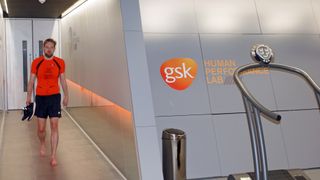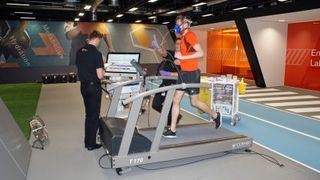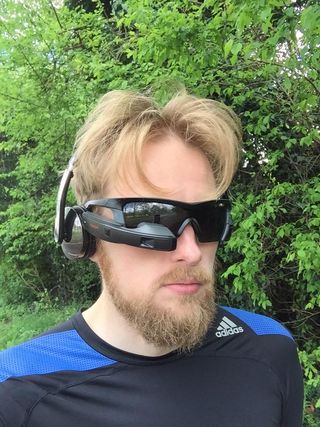What it's like to spend the morning as an elite athlete
There's nothing like sitting in an egg to be told how fat you are

This week I got a tiny taste of what it's like to be an elite athlete. It was neither nationwide adulation, nor excelling on an international stage, but I did get to swim in a very tiny swimming pool.
As part of this mad decision to try and become a triathlete in just a couple of months, I was invited down to GlaxoSmithKline's Human Performance Lab to undergo a battery of tests to determine just how fit and ready I am to take on this ludicrous challenge.
Let's recap: in just 5 weeks (wait, what, HOW LONG?) I'll be taking part in an Olympic distance triathlon in Windsor, doggy paddling 1.5km down the River Thames, cycling 32KM and then finishing it up with a lovely 10KM run in the park.
Given I did 50M in the pool three weeks ago and was nearly sick, there's a huge chance this is the absolute epitome of 'bitten off more than he can chew'. In fact, a dog would have more chance of completing this than I do right now. Except the bike bit. Although I'm sure we could find a way around that.
I digress. I headed into the anonymous HPL building and was instantly asked to get into tight swimming shorts, as I'd need to have my body fat measured. This consists of sitting in a tiny egg, wearing a swim cap and having the air pulsed to work out how much of my body was fat and how much of it was awesome bones and stuff.

Then it was off to the computer, where I was given a baseline cognitive test. This lasted 10 minutes, designed to test reaction speeds and short term memory, giving a baseline to work off.
While it seems like a simple test that involves remembering playing cards and clicking whenever something happened, it's actually a clever new system designed to work out when athletes are struggling with different conditions – be it a rugby player after concussion or a Formula One Pit Crew being tested to see how the humid and jetlagged conditions of Singapore affects their performance,
Get daily insight, inspiration and deals in your inbox
Get the hottest deals available in your inbox plus news, reviews, opinion, analysis and more from the TechRadar team.
A smaller, iPad-based, test was then administered, and one I would repeat after each physical challenge to see how fatigue affected my performance.
It's only since the advent of tablet computers and internet-based tests that this information has been accessible – as such, the world of cognitive testing is going to get a huge amount of new information to change the way we all train.
Once that was all out of the way, it was into the hydro pool to measure swimming efficiency. The water flows towards you at a certain speed, you chuck a mask on and a man with a rod holds the tubes, like he's fishing for idiot journalists while you swim against currents of varying speeds to measure swimming efficiency.

There's something about wanting to scream 'THIS IS TOO HARD' into a plastic tube in a large Jacuzzi with three men watching you swim about in tight shorts that just, I don't know, makes you feel ALIVE.
On top of that the nagging feeling that I was partaking in tests designed for elite athletes, and way above my abilities just wouldn't dissipate – Matt and Phil testing me were nothing but encouraging and helpfu;, but I was just glad the hydro pool could actually go that slow.
After a quick tapping session on the iPad it was straight into the Performance Lab, where I was strapped into a bike, another tube stuck on my face, and blood taken. As a man with three squirmy cats, I thought I'd got over the pain of needles being poked into me. I had not. Even typing this now aches.
The blood noted my lactate levels at rest (lactic acid being the stuff that enters your bloodstream and, when you push too hard and reach 'lactate threshold', makes the muscles hurt) and then I was off, pedalling to a certain rotation speed while the power gradually increased.
At regular intervals more blood was taken to determine how much lactic acid was being produced – at the point when it was being created at a rate my body couldn't remove, that was the time to stop the test.
It seemed to go alright, with regular 25 watt increases (the measurement of power coming from the legs) starting at 125 and moving up to 200 being largely OK – although I swear I was originally supposed to go to a higher target on the test before I was stopped. I didn't ask.

Then came the run, where I thought I at least had a hope of not being totally awful. There was a lovely moment where I saw my name on the same computer screen as Jenson Button – but I really didn't want to look at his numbers, given he just completed the London Marathon in 2 hours 52 minutes. And running isn't even his strongest skill.
The test was simple: every minute either speed would go up by 1km/hr, or the gradient would increase by 1%. Oh, and the mask was strapped on again to measure my wheezy output. Going to exhaustion would give my VO2 max number, the maximum level of oxygen my body could push around my body (more = good, as it feeds the muscles to work harder) and sustain a better effort.
I started, the swim and cycle still dragging through my muscles with every step. It wasn't easy, but 12 minutes, 14km/hr and 7% gradient later I was trying not to be sick as I ripped the mask off my face.
Then it was back to the cognition testing, another round of looking at loads of playing cards, before I could finally crumple into a shower and await the results next week.
I'm getting the feeling 'You should have joined the British Olympic team years ago, but there's still time' isn't going to be the top comment.
Despite it being one of the hardest physical tests (and emotional too – I'm still not really in shape and walking in nothing but tight shorts around a facility frequented by chiselled athletes wasn't pleasant) I really enjoyed the chance to push in a controlled environment… the sheer scale and ability of the HPL to monitor every element of an athlete's performance was amazing, and there's a small, sadistic part of me looking forward to going back in five and a half weeks.

Recon Jet – the takeoff
This was my first week with the Recon Jet hedset, which provides in-vision information on everything from speed to heart rate (and lets you take pictures too), and while I still need to give it a good run through, here are some early thoughts:
I'd definitely prefer to use it for cycling than running. Even adjusted for fit there was still some wiggle as my feet pounded, where on the bike it was smooth and didn't move around much.
There's also the issue of depth perception – with the display just under the right eye, it takes away your ability to just glance down at puddles and kerbs and accurately tell how far away or deep something is.
For cycling, not having to look away from where you're going is a dream, but with running I felt like I was just being lazy, transporting my Garmin's watch face into my actual face when I could just look down and see this information.
For nearly £600 / $700 (damn the exchange rate) it needs to do a little more than that – I'll go into it in greater depth next week, but I get the feeling there are a few software upgrades coming in the near future that will make the Recon Jet a more compelling buy, as right now it feels rather basic.
- · If you've got any tips, tech you want tested out or just want to mock me, I'm@superbeav on Twitter, and you can see my stumblings on Strava too.
- · Read the rest of the Running Man of Tech story here

Gareth has been part of the consumer technology world in a career spanning three decades. He started life as a staff writer on the fledgling TechRadar, and has grown with the site (primarily as phones, tablets and wearables editor) until becoming Global Editor in Chief in 2018. Gareth has written over 4,000 articles for TechRadar, has contributed expert insight to a number of other publications, chaired panels on zeitgeist technologies, presented at the Gadget Show Live as well as representing the brand on TV and radio for multiple channels including Sky, BBC, ITV and Al-Jazeera. Passionate about fitness, he can bore anyone rigid about stress management, sleep tracking, heart rate variance as well as bemoaning something about the latest iPhone, Galaxy or OLED TV.
Most Popular
